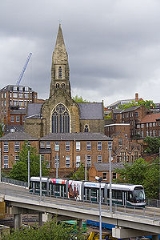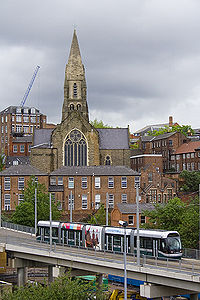
High Pavement Chapel
Encyclopedia
High Pavement Chapel is a building on High Pavement
in Nottingham
. It is now the Pitcher and Piano public house and is Grade II listed.

, two Nottingham ministers, John Whitlock and William Reynolds had been deprived of their living at St Mary's Church, Nottingham and a third, John Barret
, of his at St Peter's left town to comply with the Five Mile Act 1665
. However, they continued to preach in the area, including houses in Nottingham's Bridlesmith Gate and Middle Pavement. This led to the foundation of a permanent chapel in High Pavement
in 1690.
By 1735 the congregation had established itself as liberal and in 1802 as Unitarian. In 1758 the appointment of a new junior minister, Isaac Smithson, caused a schism. The senior minister withdrew to a new chapel in nearby Halifax Place. This schism lasted until 1775 when the two congregations merged. The original chapel was considerably rebuilt in 1805.
The current building was opened in 1876, built to a design of the architect Stuart Colman, of Bristol. It was used as a place of worship for Unitarian
Presbyterians in Nottingham until 1982. It was then converted into the Nottingham Lace Museum, but this venture proved financially unviable. The building was then converted to its current use, as a Pitcher and Piano public house.
High Pavement
High Pavement is a street in Nottingham, England. It is one of the earliest streets in the city, and most of its buildings are listed.-History:...
in Nottingham
Nottingham
Nottingham is a city and unitary authority in the East Midlands of England. It is located in the ceremonial county of Nottinghamshire and represents one of eight members of the English Core Cities Group...
. It is now the Pitcher and Piano public house and is Grade II listed.

History
By August 1662, under the Act of UniformityAct of Uniformity
Over the course of English parliamentary history there were a number of acts of uniformity. All had the basic object of establishing some sort of religious orthodoxy within the English church....
, two Nottingham ministers, John Whitlock and William Reynolds had been deprived of their living at St Mary's Church, Nottingham and a third, John Barret
John Barret (divine)
John Barret was a prominent English Presbyterian divine and writer on religion.-Training:Barret was born in Nottingham in 1631 and admitted in 1646 to Clare College, Cambridge, where he graduated BA in 1650. He went on to be ordained at Wymeswold, Leicestershire by the Wirksworth classis in 1652...
, of his at St Peter's left town to comply with the Five Mile Act 1665
Five Mile Act 1665
The Five Mile Act, or Oxford Act, or Nonconformists Act 1665, is an Act of the Parliament of England , passed in 1665 with the long title "An Act for restraining Non-Conformists from inhabiting in Corporations". It was one of the English penal laws that sought to enforce conformity to the...
. However, they continued to preach in the area, including houses in Nottingham's Bridlesmith Gate and Middle Pavement. This led to the foundation of a permanent chapel in High Pavement
High Pavement
High Pavement is a street in Nottingham, England. It is one of the earliest streets in the city, and most of its buildings are listed.-History:...
in 1690.
By 1735 the congregation had established itself as liberal and in 1802 as Unitarian. In 1758 the appointment of a new junior minister, Isaac Smithson, caused a schism. The senior minister withdrew to a new chapel in nearby Halifax Place. This schism lasted until 1775 when the two congregations merged. The original chapel was considerably rebuilt in 1805.
The current building was opened in 1876, built to a design of the architect Stuart Colman, of Bristol. It was used as a place of worship for Unitarian
Unitarianism
Unitarianism is a Christian theological movement, named for its understanding of God as one person, in direct contrast to Trinitarianism which defines God as three persons coexisting consubstantially as one in being....
Presbyterians in Nottingham until 1982. It was then converted into the Nottingham Lace Museum, but this venture proved financially unviable. The building was then converted to its current use, as a Pitcher and Piano public house.
Stained glass
- East window 1904, by Morris & Co.Morris & Co.Morris, Marshall, Faulkner & Co. and its successor Morris & Co. were furnishings and decorative arts manufacturers and retailers founded by the Pre-Raphaelite artist and designer William Morris...
, to designs by Philip Burne-JonesPhilip Burne-JonesSir Philip Burne-Jones, 2nd Baronet was the first child of the British Pre-Raphaelite artist Sir Edward Burne-Jones. He became a well-known painter in his own right, producing more than 60 paintings, including portraits, landscapes, and poetic fantasies.-Life and career:He was born in London,... - North aisle war memorial window, 1925, by Kempe & CoCharles Eamer KempeCharles Eamer Kempe was a well-known Victorian stained glass designer. After attending Twyford School, he studied for the priesthood at Pembroke College, Oxford, but it became clear that his severe stammer would be an impediment to preaching...
- Sunday School memorial window, 1906, by H Holiday
- North transept north window 1890, by H Enfield
Ministers
- John Whitlock, M.A. 1662-1708
- William Reynolds, M.A. 1662-1698
- John BarretJohn Barret (divine)John Barret was a prominent English Presbyterian divine and writer on religion.-Training:Barret was born in Nottingham in 1631 and admitted in 1646 to Clare College, Cambridge, where he graduated BA in 1650. He went on to be ordained at Wymeswold, Leicestershire by the Wirksworth classis in 1652...
, B.A. 1662-1713 - John Whitlock junior 1689-1723
- John Hardy 1714-1727
- Nathaniel Whitlock 1729-1739
- Obadiah Hughes 1728-1735
- Samuel Eaton, 0.0.1737-1759
- Joseph Evans 1754-1758
- Isaac Smithson 1758-1769
- John Milne 1759-1772
- Thomas Brushaw 1769-1772
- John SimpsonJohn Simpson (Unitarian)John Simpson was an English Unitarian minister and religious writer, known as a biblical critic. Some of his essays were very well known in the nineteenth century....
1772-1777 - George Walker, F.R.S.George Walker (Presbyterian)George Walker was a versatile English dissenter, known as a mathematician, theologian, Fellow of the Royal Society, and activist.-Life:...
1774-1798 - Nathaniel Philipps, D. D. 1778-1785
- Nicholas ClaytonNicholas Clayton (divine)Nicholas Clayton, D.D. was an English presbyterian minister and divine.-Life:Clayton was the son of Samuel Clayton of Old Park, Enfield, Middlesex, and was born about 1733...
, LL.D. 1785-1795 - William Walters 1794-1806
- Robert Kell 1799-1801
- James Tayler 1802-1831
- John Grundy 1806-1811
- William Pitt Scargill 1811
- Richard Fry 1812-1813
- Joseph Hutton, LL.D. 1813-1816
- Henry Turner 1817-1822
- Benjamin Carpenter 1822·1860
- William Blazeby, B.A. 1859-1860
- Peter William Clayden 1860-1868
- Richard Acland Armstrong, B.A. 1869-1884
- James Harwood, B.A. 1884-1892
- William Edward AddisWilliam Edward AddisWilliam Edward Addis was an Australian colonial clergyman.-Biography:Addis, the son of the late Rev. Thomas Addis, of Edinburgh, minister of the Free Church, was born in 1844, and was Snell Exhibitioner to Balliol College, Oxford...
, M.A. 1892-1899 - Joseph Morgan Lloyd Thomas 1900-1912
- John Charles Ballantyne, M. A. 1913-1918
- Simon Jones, B.A. 1918-1934
- James Arnold Williams, B.A., B.D. 1934-1946
- Charles Gordon Bolam, B.A., B.D., M.A. 1946-
Organists
- Henry Farmer ca. 1862
- William Lawrence ???? - 1883 - 1885 - ????
- William Wright ???? - 1888 - ????
- Charles Lymn ???? - 1902 - 1914 - ????
- H. Freestone ca. 1916
- C. E. Blyton Dobson 1920 - 1925
- Wilfred Davies ca. 1960s

